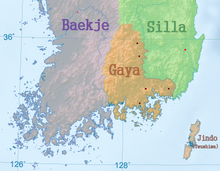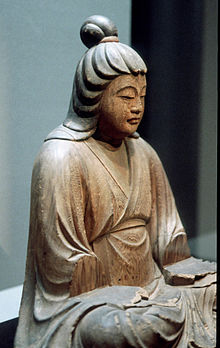Mimana

Mimana (Chinese and Japanese: 任那; pinyin: Rènnà; Korean: 임나), also transliterated as Imna according to the Korean pronunciation, is the name used primarily in the 8th-century Japanese text Nihon Shoki, likely referring to one of the Korean states of the time of the Gaya confederacy (c. 1st–5th centuries). As Atkins notes, "The location, expanse, and Japaneseness of Imna/Mimana remain among the most disputed issues in East Asian historiography."[1] Seth notes that the very existence of Mimana is still disputed.[2]
Usage of the term[]
The name 任那 (pronounced Mimana in Japanese, Imna in Korean, and Renna in Mandarin Chinese) is used over 200 times in the 8th-century Japanese text Nihongi.[3] Much earlier it is mentioned in the 5th-century Chinese history text the Book of Song in the chapter about the State of Wa.[4] It is also used in two Korean epigraphic relics, as well as in several Korean texts, including Samguk Sagi.[3]
Hypotheses about the meaning[]

The first serious hypothesis about the meaning of Mimana comes from Japanese scholars, who, based on their interpretation of Nihongi, claimed that Mimana was a Japanese-controlled state on the Korean Peninsula that existed from the time of the legendary Empress Jingū's conquest in the 3rd century to Gaya's defeat and annexation by Silla in the 6th century. This was part of the Japanese imagery for centuries, envisioning Japanese supremacy and cultural superiority over Korea's Sadae policy centered on China, and also one of the grounds for portraying the 20th-century Japanese occupation of Korea as a Japanese return to the lands they once controlled.[5][1][2][3] This early Japanese view has also been often reproduced in old Western works.[6] One of the main proponents of this theory was Japanese scholar , who in 1949 proposed that Mimana was a Japanese colony on the Korean peninsula that existed from the 3rd until the 6th century. This theory has lost popularity since the 1970s,[7] largely due to: 1) the complete lack of archaeological evidence that such a settlement would have produced,[1] 2) the fact that a centralized Japanese state with power projection capability did not exist at that time (the Yayoi period), and 3) the more likely possibility that Nihongi is describing (or misinterpreting, intentionally or not) an event that occurred centuries before its composition, in which Jingū's conquest is a dramatized and politicized version of her immigration to the Japanese Archipelago, which would have been one of many during the Yayoi period (Hanihara Kazurō has suggested that the annual immigrant influx to the Japanese Archipelago from the Asian mainland during the Yayoi period ranged from 350 to 3,000).[8]
This old Japanese interpretation has been disputed by Korean scholars. At first they simply chose to ignore it, but more recently their position has been bolstered as continuing archeological excavations on the Korean Peninsula have failed to produce any evidence supporting this hypothesis.[1][7] Korean historians generally interpret the claim about a Japanese colony in Korea as nationalistic colonial historiography, which has been accepted by some historians.[9] Korean scholar , in his 2005 book The History of Korea, discusses this topic under the section "The Mimana fallacy".[10]
Rurarz describes five main theories about Mimana, the first of which was proposed by Suematsu. A second theory about Mimana was proposed by North Korean scholar , who suggested that Mimana was a political entity from the Korean Peninsula (possibly Gaya) who had a colony on the Japanese islands, somewhere around the modern-day city of Ōyama, Ōita in Ōita Prefecture; thus Nihongi should be understood as referring only to the Japanese islands and Jingū's conquest a description of a migration to a land in the Japanese Archipelago, not the Korean Peninsula.[11][12]: p. 108–109 This is related to the so-called in which horse riders from the Korean Peninsula are hypothesized to have successfully invaded Japan, and in so doing introduced horses, not native to the islands, to Japan.[2][13] A third theory has been proposed by Japanese scholar , who argued that ancient Japanese Wa people might have settled a region in the Korean peninsula as long ago as around the Neolithic, and the Mimana state was an enclave of this group.[11] A fourth theory was put forward by South Korean scholar , who argued that the events present a history of the Korean Baekje state, which was allied with Yamato Japan, and whose leaders fled there after Baekje's fall in the 7th century. In this version, Mimana would refer to Baekje, or some poorly understood fragment of that state, that fought against Gaya.[11] The fifth theory, which Rurarz describes as a "compromise version of recent young Japanese and Korean scholars" argues that there never was a Mimana state as such, and the term refers to Japanese diplomatic envoys active in the Korean peninsula in that era.[11][14]
According to , Yamato Japan could have established an office in Gaya in order to export iron to Japan; this theory suggests that Mimana was a diplomatic embassy, and Jingū's conquest would be a dramatization of efforts undertaken to establish that embassy.[12]: p. 112
The topic of Mimana (such as its portrayal in Japanese textbooks) is still one of the controversies in Japanese-Korean relations.[7][15][16][12][clarification needed]
Linguistics[]
According to several linguists, including Alexander Vovin and Juha Janhunen, Japonic languages were spoken in large parts of the southern Korean Peninsula. Vovin suggests that these "Peninsular Japonic languages" were replaced by Koreanic-speakers (possibly belonging to the Han-branch). Janhunen also suggests that early Baekje was still predominantly Japonic-speaking before they got replaced or assimilated into the new Korean society.[17][18] However, this is the argument that, rather than the Japanese speakers newly crossing the sea conquered the southern part of the Korean Peninsula, the existing native Japanese speakers were expelled or assimilated by Korean speakers from the north.
References[]
- ^ a b c d E. Taylor Atkins (10 July 2010). Primitive Selves: Koreana in the Japanese Colonial Gaze, 1910–1945. University of California Press. pp. 114–117. ISBN 978-0-520-94768-9.
- ^ a b c Michael J. Seth (1 January 2006). A Concise History of Korea: From The Neolithic Period Through The Nineteenth Century. Rowman & Littlefield. pp. 31–32. ISBN 978-0-7425-4005-7.
- ^ a b c Rurarz 2009, p.88
- ^ Wa State, Dongyi, Book of Song (in Chinese).
- ^ Kang, Etsuko Hae-Jin (2016). Diplomacy and ideology in Japanese-Korean relations from the fifteenth to the eighteenth Century. ISBN 978-0-312-17370-8. OCLC 1073737319.
- ^ André Schmid (2002). Korea Between Empires: 1895 - 1919. Columbia University Press. pp. 169–170. ISBN 978-0-231-50630-4.
- ^ a b c Rurarz 2009, p.89
- ^ Maher, 40.
- ^ André Schmid (2002). Korea Between Empires: 1895 - 1919. Columbia University Press. p. 263. ISBN 978-0-231-50630-4.
- ^ Chun-Gil Kim (1 January 2005). The History of Korea. Greenwood Publishing Group. pp. 27–29. ISBN 978-0-313-33296-8.
- ^ a b c d Rurarz 2009, p.90
- ^ a b c Pankaj Mohan (2016). "The Controversy over the Ancient Korean State of Gaya: A Fresh Look at the Korea–Japan History War". In Michael Lewis (ed.). 'History Wars' and Reconciliation in Japan and Korea. The Roles of Historians, Artists and Activists. Palgrave Macmillan US. pp. 107–124. doi:10.1057/978-1-137-54103-1_6. ISBN 978-1-137-54102-4.
- ^ Helen Hardacre (1998). The Postwar Developments of Japanese Studies in the United States. BRILL. pp. 45–47. ISBN 978-90-04-10981-0.
- ^ Rurarz 2009, p.91
- ^ Chong-Sik Lee (1 January 1985). Japan and Korea: The Political Dimension. Hoover Press. pp. 157–159. ISBN 978-0-8179-8183-9.
- ^ Mark Peterson (1 January 2009). A Brief History of Korea. Infobase Publishing. p. 22. ISBN 978-1-4381-2738-5.
- ^ Janhunen, Juha (2010). "RECONSTRUCTING THE LANGUAGE MAP OF PREHISTORICAL NORTHEAST ASIA". Studia Orientalia 108 (2010).
... there are strong indications that the neighbouring Baekje state (in the southwest) was predominantly Japonic-speaking until it was linguistically Koreanized.
- ^ Vovin, Alexander (2013). "From Koguryo to Tamna: Slowly riding to the South with speakers of Proto-Korean". Korean Linguistics. 15 (2): 222–240.
Cite error: A list-defined reference named "Logie2019" is not used in the content (see the help page).
Bibliography[]
- Joanna Rurarz (2009). Historia Korei. Dialog. ISBN 978-83-89899-28-6.
Further reading[]
- Yasukazu Suematsu (1949). Mimana kōbō-shi: History of the rise and fall of Mimana. Ōyashima shuppan.
- In Ho Kim (1973). Concerning the Mimana Problem from the Point of View of Japanese History: A Research.
- Grayson, James H. "Mimana, A Problem in Korean Historiography." Korea Journal 17, no. 8 (1977): 65-69
- Lee, Chong-sik. "History and politics in Japanese-Korean relations: The textbook controversy and beyond." East Asia 2, no. 4 (1983): 69–93
- Gina Lee Barnes (2001). State Formation in Korea: Historical and Archaeological Perspectives. Curzon. pp. 38–39. ISBN 978-0-7007-1323-3.
- Gaya confederacy
- Japan–Korea relations